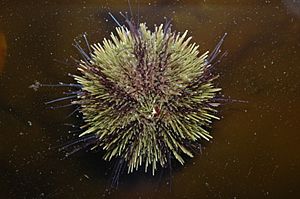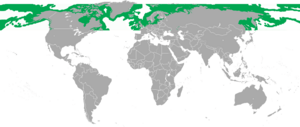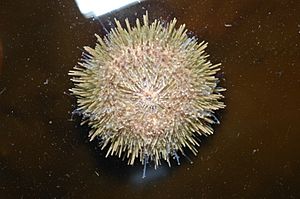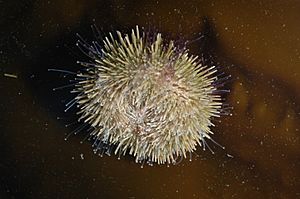Strongylocentrotus droebachiensis facts for kids
Quick facts for kids Green sea urchin |
|
|---|---|
 |
|
| Scientific classification | |
| Kingdom: | |
| Phylum: | |
| Class: | |
| Subclass: |
Euechinoidea
|
| Order: |
Echinoida
|
| Family: |
Strongylocentrotidae
|
| Genus: |
Strongylocentrotus
|
| Species: |
S. droebachiensis
|
| Binomial name | |
| Strongylocentrotus droebachiensis (Müller, 1776)
|
|
 |
|
| Strongylocentrotus droebachiensis range | |
The green sea urchin is a cool sea creature. Its scientific name is Strongylocentrotus droebachiensis. It gets its common name from its green color.
You can find these urchins in cold northern waters all over the world. They live in both the Pacific Ocean and Atlantic Ocean. They are found as far north as 81 degrees latitude. In the U.S., they live as far south as Maine. In Europe, you can find them near England.
Most adult green sea urchins are about 50 millimeters (2 inches) wide. But some have been found to be as big as 87 millimeters (3.4 inches) across! Green sea urchins mostly eat seaweeds. But they can also eat other small living things. Many animals like to eat green sea urchins. These include sea stars, crabs, big fish, mammals, and birds. Even humans eat them! The name "droebachiensis" comes from a town in Norway called Drøbak.
Contents
Where Green Sea Urchins Live
Green sea urchins live on rocky bottoms. You can find them in shallow areas near the shore. They also live in deep water, up to 1,150 meters (3,770 feet) deep.
This sea urchin uses a special mouth part called an Aristotle's lantern to dig into rocks. It can make a home for itself in the rock. Then, it uses its spines to make the hole wider. Usually, the urchin can leave its hole to find food. Then it comes back. But sometimes, the hole gets bigger and deeper inside. This makes the opening too small for the urchin to get out!
Green sea urchins can live in water with low salt levels. This helps them grow well in places like southern Puget Sound. Bigger urchins can handle changes in salt levels better than smaller ones.
Green Sea Urchin Body Parts
The green sea urchin looks like a slightly flat ball. Its mouth side rests on the ground. The other side, with its anus, faces up. It has five parts that are the same, like a star. You can see this in the five pairs of tube feet rows. These rows run from the anus to the mouth.
We measure the size of a sea urchin by its test (body) diameter. This does not include the spines. Green sea urchins grow quite fast. You can often guess their age by their size. For every 10 millimeters (0.4 inches) of size, it's usually one year old.
Outer Body Parts
Spines
The spines of the green sea urchin are for defense. They also help the urchin move around. These spines are not poisonous. The spines connect to small bumps on the body. Muscles hold them in place, like a ball and socket joint.
The spines are round and pointy. They have ridges that look like a fan. They are made of calcium carbonate. The longest spines are usually around the edge of the urchin. If a spine breaks, it will grow back. If a spine is completely pulled off, the bump it was on will shrink. Then, a new spine will slowly grow.
Tube Feet
Tube feet help the green sea urchin stick to surfaces. They also help it move. They can also grab small food bits and move them to its mouth. Tube feet are very flexible. They can stretch out longer than the spines. This helps them reach the ground or grab food floating in the water. They come out of five pairs of rows on the body.
Each tube foot has two parts: the ampulla and the podium. The ampulla is a hollow, bulb-like part. It pushes the tube foot up. The podium extends from the ampulla. It has muscles and a suction cup for sticking.
Tube foot movement uses water pressure from the water vascular system. It also uses muscle action. When the ampulla squeezes, it pushes liquid into the podium. This makes the podium stretch out. Once the podium sticks to something, its muscles squeeze. This pushes the liquid back into the ampulla. This makes the podium shrink. This pulls the urchin's body in that direction. Or it pulls food closer to the mouth. If tube feet get pulled off by strong waves, they grow back quickly.
Pedicellariae
Sea stars and sea urchins have tiny pincer-like jaws. These are called pedicellariae. They are on stalks at the base of the spines. These tiny pincers can react to things on their own. They don't need the main nervous system.
People used to think pedicellariae were parasites. Now, we know they are part of the sea urchin. The muscles that control them are outside the body. They might get food directly from the water.
Pedicellariae help the sea urchin in many ways. They keep dirt from building up on the body. They can also grab kelp to cover the urchin. This protects it from drying out in the sun. Their pinching jaws can even defend against predators. Some pedicellariae on the green sea urchin are even poisonous!
If the spines are gently touched, they move closer together. But if they are pushed hard, they spread apart. This lets the pedicellariae pinch the intruder. One type of pedicellariae on the green sea urchin is poisonous. It can be used for defense. It can also paralyze small fish. Even though this urchin prefers algae, it will catch and eat fish for extra food.
Test
The sea urchin's hard body is called a test. It's like an exoskeleton. It is made of 20 curved plates called ossicles. These plates are fused together. They are made of calcium carbonate. Each plate has two rows of holes. The tube feet pass through these holes. If the test cracks, calcium carbonate slowly fills the gaps. The test becomes complete and strong again.
Inner Body Parts
Water Vascular System
The water vascular system is a network of canals. Fluid moves through these canals. This fluid helps the sea urchin's tube feet move. The fluid is like seawater. But it also has special cells and proteins. It has a lot of potassium, more than the surrounding seawater. Tiny hairs called cilia line the canals. They help move the fluid in the right direction.
The water vascular system has several hard parts. The first is the madreporite. This is a sieve-like plate on the top surface. It's an opening to the water vascular system. Below the madreporite is a cup-shaped part called the ampulla. Next, the stone canal carries the liquid to the center of the urchin. Finally, five lateral canals run inside the test. They meet at the top. Along this path, tube feet come out of the lateral canals. They pass through the test to the outside.
Aristotle's Lantern
Green sea urchins eat using a special mouth part. It's called an Aristotle's lantern. This part scrapes or tears food into small pieces. It has five hard, movable teeth. Strong muscles control these teeth. The sea urchin crawls onto its food. Then it uses the Aristotle's lantern to tear and chew it. If food lands on the top of the urchin, or is caught by pedicellariae, the tube feet carry it to the mouth. Then it's eaten the same way.
Digestive System
The digestive system starts with the Aristotle's lantern. Food enters the body here. A tube called the esophagus goes from the mouth. It passes through the center of the Aristotle's lantern. It then connects to an intestine. The intestine is coiled in bundles. It sticks to the inside of the test. It goes in a counter-clockwise circle around the Aristotle's lantern. Then it doubles back and goes in a clockwise direction.
The walls of the intestine make Digestive enzymes. These enzymes break down food outside of cells. What's left of the food moves from the intestine into a short rectum. Then it leaves the body through the anus. The green sea urchin gets its green color from the pigments in the plants it eats.
Nervous System
In sea urchins, the spines, tube feet, and pedicellariae all act as sensors. A nerve ring goes around the esophagus. Nerves also extend inside the test. They run next to the lateral canals of the water vascular system. Sensory cells in the skin can feel touch, chemicals, and light. These cells are often near pedicellariae or spines.
Green Sea Urchin Life and Environment
Small Snails sometimes live on the surface of the green sea urchin. They attach their eggs to the base of the spines for protection.
Green sea urchins eat algae. They prefer certain types of algae like Sargassum muticum and Mazzaella japonica. They don't like Saccharina latissima, Ulva, and Chondracanthus exasperatus as much.
Sometimes, a disease called paramoebiasis causes many green sea urchins to die. This disease is caused by a tiny living thing called Paramoeba invadens. Many deaths happen when the water temperature is around 12°C (53.6°F). Big storms might also help spread the amoeba to urchin groups.
Green Sea Urchins as Food
The green sea urchin is safe to eat. We know that Native peoples in New Brunswick ate them long ago. This was found from old remains. The Inuit people of the Belcher Islands still harvest and eat them all year.
Green sea urchins are also caught for export. This means they are sent to other countries. Places like Newfoundland and Labrador, Iceland, and Norway do this. In France, sea urchin is often part of a seafood platter called "Plateau de fruits de mer".
Famous chefs like René Redzepi have used green sea urchins in fancy meals. They use them raw or cured.
How Green Sea Urchins Are Fished
People use different ways to catch green sea urchins.
In Iceland, in a place called Breiðafjörður, they use trawling nets. They fish in waters from 8 to 30 meters (26 to 98 feet) deep. This type of fishing is controlled by rules.
In Norway, small amounts are caught by hand. People who free-dive or SCUBA-dive collect them. There are no rules for this fishing. The green sea urchin is seen as a pest in Norway. It eats too much of the kelp forests. You usually don't find green sea urchins south of Hitra. The urchin population is moving north as water temperatures get warmer.
In Canada, in Newfoundland and Labrador and British Columbia, SCUBA-divers catch them. This fishing is also controlled by rules.
In the USA, the rules for fishing vary by state. In Maine, they use both trawling and SCUBA diving. This depends on the exact location. The best time to fish in Maine is from September to March. This fishery is also regulated. In Washington State, divers catch them. This is also a regulated fishery.
Images for kids







